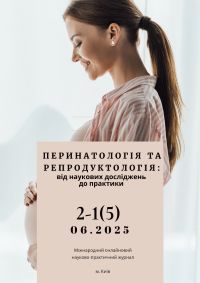Features of course of pregnancy at infertility at married couples
Keywords:
infertility, married couples, pregnancy, complicationAbstract
DOI: 10.52705/2788-6190-2025-02.1-18
УДК 618.177-058.833:618.3-036.1-039
The objective: to learn the features of course of pregnancy at infertility at married couples and application of donor oocyte.
Materials and methods. In obedience to the put purpose 135 women were up-diffused on three clinical groups. In a basic group women were plugged with making progress pregnancy after the oocyte donation (n = 32). In a group comparisons are women with making progress pregnancy after in vitro fertilization without the donor programs (n = 53). A control (n = 50) group was formed with including de bene esse of healthy women with spontaneously coming pregnancy in the natural menstrual loop, with the physiological course of pregnancy and births. Plugging criteria in a basic group: reproductive age, desirable pregnancy, application of oocyte donation because of mionectic ovarian reserve. Plugging criteria in the group of comparison: reproductive age, desirable pregnancy, application of assisted reproductive technologies without the oocyte donation. Criteria of exception for all groups: surrogacy, other testimonies for the oocyte donation, except for mionectic ovarian reserve, obstetric or extragenital pathology with the high risk of decompensation. Clinical, laboratory, instrumental and statistical methods were plugged in the complex of the conducted researches.
Results. The III trimester of pregnancy in women with assisted reproductive technologies differed the ultrasonic markers of placenta dysfunction (not only oligohydroamnios, violations of uterofetal-placenta hemodynamics but also by the fetal growth retardation) in women I and the II groups with comparable frequency (р>0,05), by more late term of appearance at a debut in the II trimester in women with the oocyte donation, what without the oocyte donation (26,35 ± 0,91 week, 23,76 ± 0,82 weeks, р < 0,05). For women with the oocyte donation, in a difference here women without the oocyte donation, pregnancy was not complicated by heavy preeclampsia, or early debut of preeclampsia. For women with assisted reproductive technologies, regardless of presence or absence of oocyte donation, pregnancy was associated with the risk of serious complications – intrahepatic cholestasia of pregnant, preeclampsia, gestational arterial hypertension. Reliable differences in frequency of bacteriuria, cervicitis, vaginitis, premature break of fruit shells and in the term of pregnancy at the premature ruptured membranes for women both with the oocyte donation and without the oocyte donation exposed it was not.
Conclusions. At pregnancy after in vitro fertilization with the oocyte donation megascopic: risk of early appearance (18,44 ± 0,38 week) of ultrasonic markers of placenta dysfunction, frequency of exposure of hypertransaminasemia (84%), but frequency of exposure of intrahepatic cholestasia is mionectic, preeclampsia, gestational arterial hypertension, what at pregnancy after assisted reproductive technologies without the oocyte donation. The got results must be taken into account at development of algorithm of diagnostic and treatment-and-prophylactic measures.
Downloads
Published
How to Cite
Issue
Section
License

This work is licensed under a Creative Commons Attribution-ShareAlike 4.0 International License.


